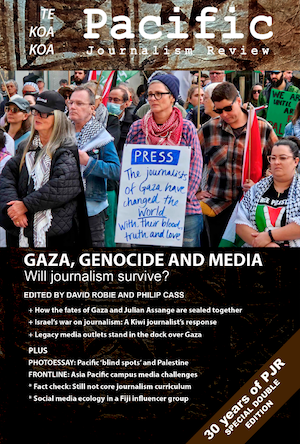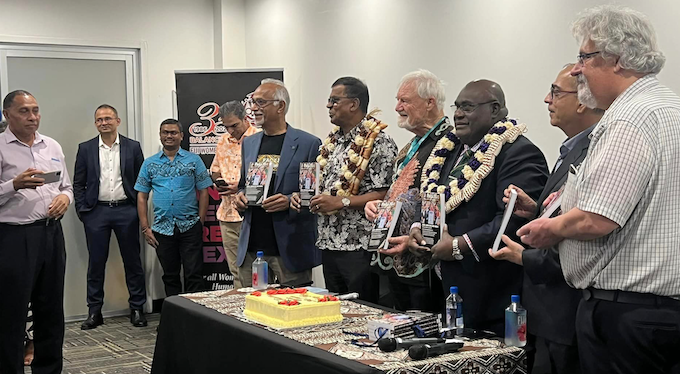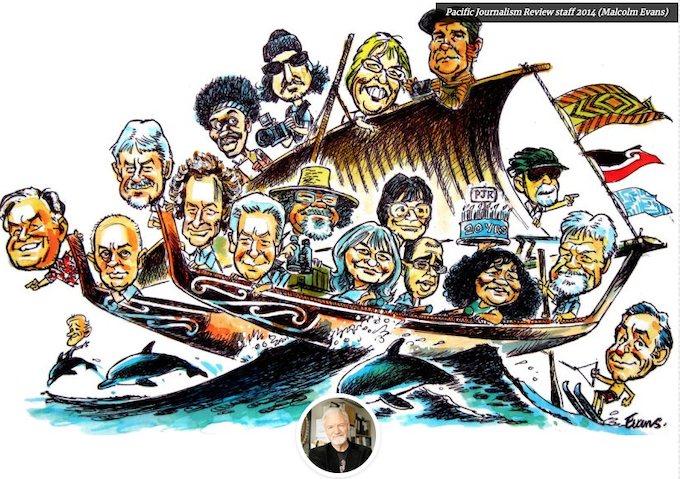COMMENTARY: By David Robie in Devpolicy Blog
Pacific Journalism Review (PJR) began life three decades ago in Papua New Guinea and recently celebrated a remarkable milestone in Fiji with its 30th anniversary edition and its 47th issue.
Remarkable because it is the longest surviving Antipodean media, journalism and development journal published in the Global South. It is also remarkable because at its birthday event held in early July at the Pacific International Media Conference, no fewer than two cabinet ministers were present — from Fiji and Papua New Guinea — in spite of the journal’s long track record of truth-to-power criticism.
Fiji’s Deputy Prime Minister Biman Prasad, a former economics professor at The University of the South Pacific (USP) and a champion of free media, singled out the journal for praise at the event, which was also the occasion of the launch of a landmark new book. As co-editor of Waves of Change: Media, Peace, and Development in the Pacific with Shailendra Singh and Amit Sarwal, Prasad says the book aimed to analyse recent developments in the Pacific because if sustainable peace and stability remain elusive in the region then long-term development is impeded.
Papua New Guinea’s Information and Communication Technologies Minister Timothy Masiu, who has faced criticism over a controversial draft media policy (now in its fifth version), joined the discussion, expressing concerns about geopolitical agendas impacting on the media and arguing in favour of “a way forward for a truly independent and authentic Pacific media”.
Since its establishment in 1994, the PJR has been far more than a research journal. As an independent publication, it has given strong support to Asia-Pacific investigative journalism, socio-political journalism, political-economy perspectives on the media, photojournalism and political cartooning in its three decades of publication. Its ethos declared:
While one objective of Pacific Journalism Review is research into Pacific journalism theory and practice, the journal has also expanding its interest into new areas of research and inquiry that reflect the broader impact of contemporary media practice and education.
A particular focus is on the cultural politics of the media, including the following issues: new media and social movements, indigenous cultures in the age of globalisation, the politics of tourism and development, the role of the media and the formation of national identity and the cultural influence of Aotearoa New Zealand as a branch of the global economy within the Pacific region.
It also has a special interest in climate change, environmental and development studies in the media and communication and vernacular media in the region.
PJR has also been an advocate of journalism practice-as-research methodologies and strategies, as demonstrated especially in its Frontline section, initiated by one of the mentoring co-editors, former University of Technology Sydney professor and investigative journalist Wendy Bacon, and also developed by retired Monash University Professor Chris Nash. Five of the current editorial board members were at the 30th birthday event: Griffith University’s Professor Mark Pearson; USP’s Associate Professor Shailendra Singh, the conference convenor; Auckland University of Technology’s Khairiah Abdul Rahman; designer Del Abcede; and current editor Dr Philip Cass.

As the founding editor of PJR, I must acknowledge the Australian Journalism Review which is almost double the age of PJR, because this is where I first got the inspiration for establishing the journal. While I was head of journalism at the University of Papua New Guinea in 1993, I was really frustrated at the lack of quality Pacific-specific media and journalism literature and research to draw on as resources for both critical studies and practice-led education.
So I looked longingly at AJR, and also contributed to it. I turned to the London-based Index on Censorship as another publication to emulate. And I thought, why not? We can do that in the Pacific and so I persuaded the University of Papua New Guinea Press to come on board and published the first edition at the derelict campus printer in Waigani in 1994.
We published there until 1998 when PJR moved to USP for five years. Then it was published for 18 years at Auckland University of Technology (AUT), mostly through the Pacific Media Centre, which closed in 2020. Since then it has been published by the nonprofit NGO Asia Pacific Media Network.
When celebrating the 20th anniversary of the journal at AUT in 2014, then AJR editor professor Ian Richards noted the journal’s “dogged perseverance” and contribution to Oceania research declaring:
Today, PJR plays a vital role publishing research from and about this part of the world. This is important for a number of reasons, not least because most academics ground their work in situations with which they are most familiar, and this frequently produces articles which are extremely local. If “local” means London or Paris or New York, then it’s much easier to present your work as “international” than if you live in Port Vila of Pago Pago, Auckland or Adelaide.
Also in 2014, analyst Dr Lee Duffield highlighted the critical role of PJR during the years of military rule and “blatant military censorship” in Fiji, which has eased since the repeal of its draconian Media Industry Development Act in 2023. He remarked:
The same is true of PJR’s agenda-setting in regard to crises elsewhere: jailing of journalists in Tonga, threatened or actual media controls in Tahiti or PNG, bashing of an editor in Vanuatu by a senior government politician, threats also against the media in Solomon Islands, and reporting restrictions in Samoa.

At the 30th anniversary launch, USP’s Adjunct Professor in development studies and governance Dr Vijay Naidu complimented the journal on the wide range of topics covered by its more than 1,100 research articles. He said the journal had established itself as a critical conscience with respect to Asia-Pacific socio-political and development dilemmas, and looked forward to the journal meeting future challenges.
I outlined many of those future challenges in a recent interview with Global Voices correspondent Mong Palatino. Issues that have become more pressing for the journal include responding to the changing geopolitical realities in the Pacific and collaborating even more creatively and closely on development, the climate crisis, and unresolved decolonisation issues with the region’s journalists, educators and advocates. To address these challenges, the PJR team have been working on an innovative new publishing strategy over the past few months.

View the latest Pacific Journalism Review: Gaza, genocide and media – PJR 30 years on, special double edition. The journal is indexed by global research databases such as Informit and Ebsco, but it is also available via open access for a Pacific audience here.
This article is republished from ANU’s Devpolicy Blog. Dr David Robie is founding editor of Pacific Journalism Review, former director of the Pacific Media Centre, and previously a head of journalism at both the University of Papua New Guinea and the University of the South Pacific.
This content originally appeared on Asia Pacific Report and was authored by Pacific Media Watch.
Pacific Media Watch | Radio Free (2024-08-02T06:18:12+00:00) Pacific Journalism Review at 30 – a strong media legacy. Retrieved from https://www.radiofree.org/2024/08/02/pacific-journalism-review-at-30-a-strong-media-legacy/
Please log in to upload a file.
There are no updates yet.
Click the Upload button above to add an update.